A teacher is teaching students to read a sentence,and using her arm to show which part should be read strongly and when should stop.What is the teacher teaching in this activity?A.Stress of words B.Pronunciations of syllabications C.Intonations and rhythm
题目
B.Pronunciations of syllabications
C.Intonations and rhythms
D.Pronunciations of each letter
相似考题
参考答案和解析
题干是一个老师正在教学生们读一个句子,同时用胳膊来指示哪部分需要重读,哪部分需要停顿,请问老师在这个活动中在教什么? 关键词是一个句子,重读和停顿。
C选项,是声调和节奏,符合题意,故此题的正确选项为C。
A选项,是单词重音,不合题意,故排除。
B选项,是音节的发音,不合题意,故排除。
D选项,是每个字母的发音。题干中说的是句子的重音与停顿,不合题意,故排除。
故此题的正确选项为C。
更多“A teacher is teaching students to read a sentence,and using her arm to show which part should be read strongly and when should stop.What is the teacher teaching in this activity?”相关问题
-
第1题:
In teaching pronunciation, the teacher should tell the students that __________can be used to convey more important messages.A.rhyme
B.stress
C.devoicing
D.rhythm答案:B解析:考查英语语音教学。英语中的重音可以用来表示强调,表达重要信息。 -
第2题:
A teacher asked the students to repeat a word many times to memorize the pronunciation,meanings and usages.Which conclusion is NOT correct?A.The teacher is teaching pronunciation.
B.The teacher focuses on accuracy.
C.The teacher is using mechanical practice.
D.The teacher is teaching vocabulary.答案:A解析:考查词汇教学
一位老师让学生重复了一个生词很多遍,以此来记忆该生词的发音、意思和用法。以下结论哪个不正确?
A是老师正在教授发音,题干中不仅说到了发音,还说到了意思和用法,这都是词汇教学的内容,故此题的正确选项为A。
B是这个老师注重准确性,不合题意,故排除。
C是老师正在使用机械练习法,不合题意,故排除。
D老师正在教授词汇,不合题意,故排除。
故此题的正确选项为A。 -
第3题:
Which of the following statements about take-based language teaching is NOT true?A.Students should be given tasks to perform or problems to solve in the classroom.
B.Student are task-driven.
C.Task-based language teaching is student-centered.
D.Task-based language teaching is teacher-centered.答案:D解析:考查任务型语言教学。任务型语言教学以学生为主体,以任务为中心,学生通过参与和完成一系列的任务来习得语言知识。任务型语言教学法与3P教学模式不同,任务型教学法的基本学习步骤分为前任务(pre.task)、任务环(task cycle)和语言聚焦(language focus)三个部分,“3P”教学法包括演示(presentation)、操练(practice)、成(production)个阶段。两种不同的教学法都属于语言教学法的分支。故选D。 -
第4题:
Which of the folIowing statements about take-based language teaching is NOT true?A.Students should be given tasks to perform or problems to solve in the classroom.
B.Students are task-driven.
C.Task-based language teaching is student-centered.
D.Task-based language teaching is teacher-centered.答案:D解析:考查任务型语言教学。任务型语言教学以学生为主体,以任务为中心,学生通过参与和完成一系列的任务来习得语言知识。任务型教学法的基本学习步骤分为前任务(pre.task)、任务环(task cvcle)和语言聚焦(1anguage focus)三个部分。故选D。 -
第5题:
A teacher is teaching students to read a sentence, and using her arm to show which part should be read strongly and when should stop. What is the teacher teaching in this activity?A.Stress of words
B.Pronunciations of syllabications
C.Intonations and rhythms
D.Pronunciations of each letter答案:C解析:考查语音教学
题干是一个老师正在教学生们读一个句子,同时用胳膊来指示哪部分需要重读,哪部分需要停顿,请问老师在这个活动中在教什么? 关键词是一个句子,重读和停顿。
C选项,是声调和节奏,符合题意,故此题的正确选项为C。
A选项,是单词重音,不合题意,故排除。
B选项,是音节的发音,不合题意,故排除。
D选项,是每个字母的发音。题干中说的是句子的重音与停顿,不合题意,故排除。
故此题的正确选项为C。 -
第6题:
初中英语?语音
一、考题回顾
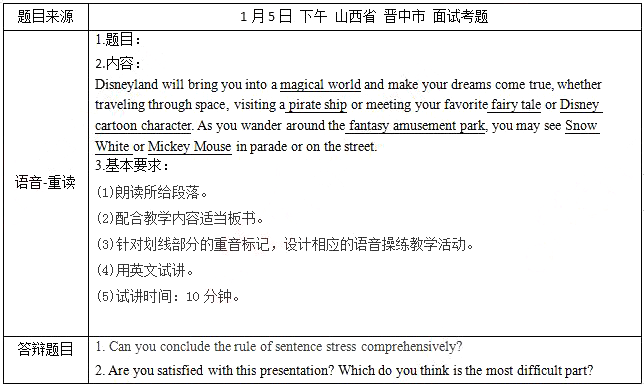
二、考题解析
【教案】
Teaching aims:
Knowledge aim:
Students will know the rule of logical stress in a complete sentence.
Ability aim:
Students will use the logical stress correctly and know how to make use of the sentence stress in different sentences correctly.
Emotional aim:
Students will be more confident in speaking English.
Key and difficult point:
Key Point: Students will master the rule of logical stress in sentences in English.
Difficult Point: Students can use the logical stress in sentences in daily life.
Teaching procedure:
Step 1: Warming-up
1. Greetings.
2. Listen to an English song and feel about the tune of the melody. Let students to know that not only songs but also the language has its stress in order to express different emotions.
Step 2: Presentation
1. Work in pairs to read the passage by themselves and ask them to pay more attention to the sentence stress. After practice, ask one pair to perform it and others should tell their opinion whether they agree or not.
2. Listen to the tape of the passage and find out whether the students themselves make any mistakes. Then let students find out the rule of the sentence stress (logical stress ) with the help of the teacher: in a sentence we can stress the important part according to the meaning of the passage. After the students find the rule, the teacher read the passage and let them repeat after it.
Step 3: Practice
1. Ask students to read the passage by themselves again and they should use the correct logical stress while reading.
2. Give students more sentences and ask them read the sentences by themselves using the logical stress.
Step4: Production
Let students work in groups of 4 and make a dialogue about the theme parks, such as the theme, the feature, the activities and so on, and they should use the rule of logical stress learned in the class. After that invite two groups to share their outcomes with the whole class.
Step5: Summary and Homework
Summary: ask a student to conclude the content of the lesson and summarize with the whole class.
Homework: ask students to read the work of Shakespeare’s and use the logical stress learned today after class.
Blackboard design:
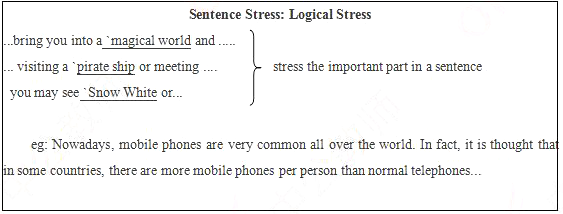
1. Can you conclude the rule of sentence stress comprehensively?
2. Are you satisfied with this presentation? Which do you think is the most difficult part?答案:解析:1.
As far as I’m concerned, there are two sentence stress rules: logical stress and grammatical stress. Logical stress is what i have presented in the presentation. The grammatical stress refers to that we need to stress notional word, which usually contains noun, verb, adjective adverb and so on. At the same time, the functional word needn’t to be stressed, which usually includes conjunction, article and preposition.
2.
The difficulty in my eyes is: first of all, without the participation of students, because of the teaching reasons, I can not interact effectively with students based on their feedback. In this case, it is difficult for me to organize classroom teaching activities and achieve the desired results. Second, what I need to improve is to introduce the key points to the students in a way that is easy to accept and adapt to the environment without an atmosphere of spoken English, because my spoken English is not very fluent, and I am very concerned about this interview. So I felt a little nervous. However, all these factors did not affect my overall performance. In view of the above problems, I will constantly reflect, and learn from experience in practice to improve my teaching ability. In short, I am basically satisfied with the presentation. -
第7题:
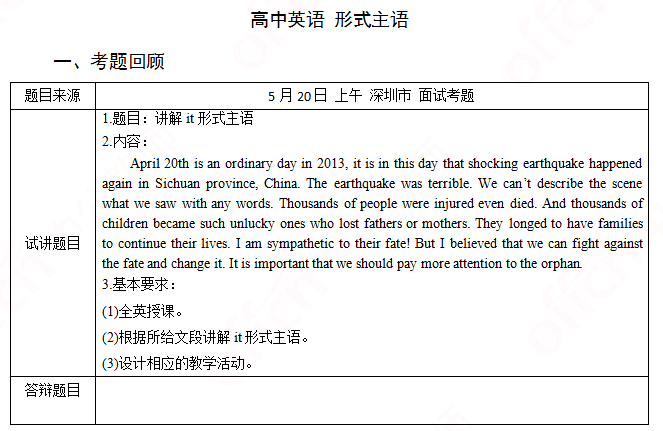
二、考题解析
【教案】
Teaching aims:
Knowledge aim: Students can master the usage of formal subject.
Ability aim: Students can use formal subject to communicate in their daily life.
Emotional aim: Students can enhance their interest in learning English.
Key and difficult point: Students can use formal subject to communicate in their daily life.
Teaching procedure:
Step 1: Warming-up
The teacher plays a documentary video about the earthquake in Wenchuan. Then asks students to talk about their feelings after watching. And lead in the topic.
Step 2: Presentation
The teacher lets students to read the passage and get the main idea. Then the teacher picks the last sentence out. The teacher will use the sentence as example to explain the structure and usage of formal subject.
Step 3: Practice
After explaining, the teacher will show some normal sentences. Students should transfer them into formal subject structure.
For example: Taking good care of the orphans is very important.
→It is very important to take good care of the orphans.
Step4: Production
The teacher lets students talk with their deskmates. They should come up with some ways to help the orphans. Then invites some students to show their opinions.
Step5: Summary and Homework
The teacher summarizes what they have learnt today. Then after class, students could say something to these orphans and take a video. The teacher will help them sent it to the orphan.
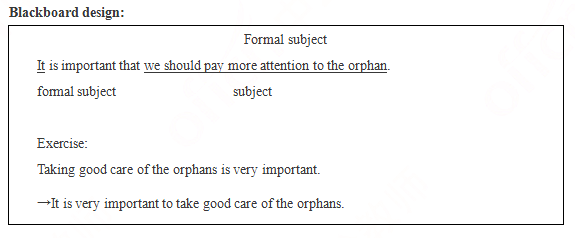
答案:解析:暂无解析 -
第8题:
单选题When students are given the structure in an authentic or near authentic context and are asked to work out the rule for themselves, what kind of method their teacher is using?ADeductive grammar teaching.
BInductive grammar teaching.
CTraditional grammar teaching.
DCommunicative teaching.
正确答案: B解析: -
第9题:
单选题The teacher should focus students' attention on ____, not only the use oflanguage form in teaching speaking.Alanguage meaning
Baccent
Corigin of language
Dinterlocutor
正确答案: A解析: -
第10题:
单选题When students learn apple, orange, the teacher gives students another word fruit. Which principle does the teacher follow in his/her vocabulary teaching?AWord-choice principle,
BPresentation principle.
CCulture principle.
DSystematic principle.
正确答案: D解析: -
第11题:
单选题About principles of teaching reading, which description is wrong?AThe selected texts and attached tasks should be accessible to the students.
BTasks should be given after reading.
CTasks should help develop students' reading skills rather than test their reading compre-hension.
DThe teacher should provide enough guidance and assistance at the beginning.
正确答案: C解析: -
第12题:
单选题In teaching pronunciation, the teacher should tell the students that ___ can beused to convey more importantmessages.Athyme
Bstress
Cdevicing
DRhythm
正确答案: A解析: -
第13题:
When the teacher gives feedback to students in teaching writing, he/she should NOT__________.A.make positive comments on the good features of the writing
B.give words simply like "good" or "very good" to the writing
C.point out areas for improvement
D.express his/her personal opinion on the issue the writer has discussed答案:B解析:考查教学反馈。教师给予学生反馈时,不能仅仅写个简单的评语“好”,这对于学生写作技能的提高没有任何帮助:而应该指出哪里写得好,哪里有待改进,并针对学生在作文中发表的观点给出自己的意见。故选B。 -
第14题:
Which of the following should a teacher avoid when his/her focus is on developing students' ability to use words appropriately?A.Teaching both the spoken and written form.
B.Teaching words in context and giving examples.
C.Presenting the form, meaning, and use of a word.
D.Asking students to memorize bilingual word lists.答案:D解析:本题考查语言知识教学。题干的意思:如果教师专注于培养学生恰当地使用单词的能力,那么他/她应该避免以下哪种方式A项“教单词的口语和书面形式”,B项“在语境中教单词并举例子”,C项“呈现单词的形式、意义及用法”,D项“要求学生记忆双语单词表”。在词汇教学中,教师不仅要讲授单词的形式,还要创设具体的语境,让学生在运用中加深对词汇意义的理解,掌握词汇的用法和功能,进而恰当得体地运用词汇表情达意。记忆双语单词表属于单纯的记忆活动,不能起到促进学生恰当使用词汇的作用。故本题选D。 -
第15题:
When the teacher gives feedback to students in teaching writing, he/she should NOTA.make positive comments on the good features of the writing
B.give words simply like "good" or "very good" to the writing
C.point out areas for improvement
D.express his/her personal opinion on the issue that student has written答案:B解析:考查写作教学。教师对学生的作文进行反馈时,不能仅仅写个简单的评语“好”,这对于学生写作技能的提高没有任何帮助;而应该指出哪里写得好,哪里有待改进,并针对学生在作文中发表的观点给出自己的意见。故选B。 -
第16题:
When teaching students how to give appropriate responses to a congratulation or an apology,the teacher is probably teaching at _________.
A.lexical level
B.sentence level
C.grammatical level
D.discourse level答案:D解析:考查语篇教学。题干的意思是当教给学生如何对祝贺和道歉进行合适的回应时,老师可以以下哪个层次进行教学。A项是词汇层次,B项是句式层次,C项是语法层次,D项是话语(语篇)层次。祝贺和道歉属于交流,是语言功能的运用,通过话语层次教学,可以有利于学生经历真实语境,提高语言运用的准确性。故选D。 -
第17题:

二、考题解析
【教案】
Teaching aims
Knowledge aim: students will know the pronunciation of the group of letter “ear”.
Ability aim: students can read words with “ear” when they learn vocabulary.
Emotional aim: students will be more interested in speaking English.
Key and difficult points:
How to pronounce the group of letter “ear”.
Teaching procedure:
Step 1: Warming-up
After greeting students, the teacher plays a game to warm up the class: I say you point. The teacher speaks out a certain part of the body and students point it quickly. For example: point your eye! Point your ear! Point your hand!
Step 2: Presentation
Draw a ear on the blackboard and ask students what it is. Write down the word. Then ask what ears can be used to, and they will say we use ear to hear something. Write down word “hear”. Then do the action of hearing and put hands near the ear, and write down the word “near”.
Ask students to read the three words after the teacher, and find out the similarity among them. After discussion, they will say all these words have “ear”. Then ask students how to pronounce this group of letter. We will know it pronounce as /ir/.
Step 3: practice
Give students some other words with the group of letter “ear” and ask students to read them by groups. For example, a sentence “my dear, your tear is clear in my mind for years”. Then students can have a brainstorming and think of more words with “ear”.
Play a game Hot potato to practice these words. The teacher plays a piece of music. When the music is playing, students pass the ball from one to another. When the music stops, the one who gets the ball should read words on the blackboard.
Step4: Production
Do a chant with students: put your ear, near my ear, and you will hear, and you will hear, and you will hear, NOTHING!
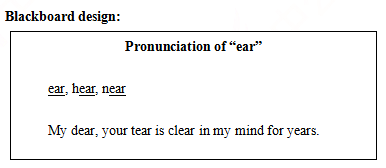 答案:解析:暂无解析
答案:解析:暂无解析 -
第18题:
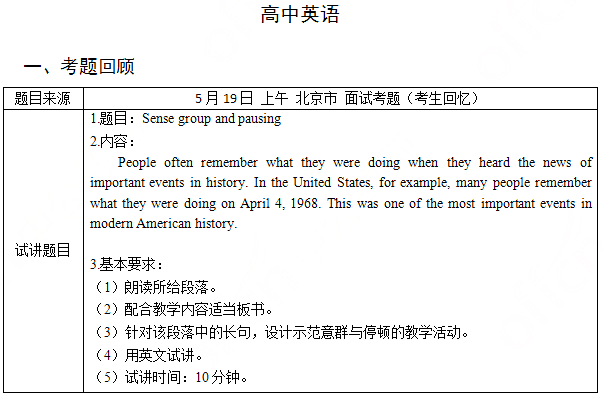
二、考题解析
【教案】
Teaching Aims:
Knowledge aim: Students will know what sense group is and master how to pause between sense groups.
Ability aim: Students can use the method to divide a long sentence into several parts and read the sentence more fluently.
Emotional aim: Students will improve their intonation and not be afraid of speaking English.
Teaching Key Points:
Students know the concept of sense group and pausing point of a long sentence.
Teaching Difficult Points:
Students can apply the pause between sense groups into daily reading to improve their pronunciation and intonation.
Teaching Methods:
Communicative teaching method, task-based teaching method, Audio-lingual teaching method.
Teaching Aids:
PPT, Blackboard and so on
Teaching Procedures:
Step 1: Warming up
1. Greetings
2.A tongue twister: I wish to wish the wish you wish to wish, but if you wish the wish the witch wishes, I won't wish the wish you wish to wish.
Step 2: Presentation
1.Ask students how to read a sentence quickly and in rhyme.
2.Read the first sentence twice. The first time without sense group pausing and the second time with it. Let students compare the two and find out the difference. Sense group is a meaning unit.
3.Explain the principle of sense group, which is according to
(1)grammar
(2)meaning
(3)punctuation
4. Divide the first sentence mainly according to grammar.
Step 3: Practice
1. Students read the first sentence, pausing according to sense group.
2. Students try to divide sense groups of the second sentence and read it.
Step 4: Production
Role-play: Students imagine a dialogue with a foreigner and apply sense group pausing in the dialogue. teacher will give them 10 minutes to prepare it and 10 minutes later, invite some students to role the conversation in the front.
Step 5: Summary & Homework
Summary : students look at the blackboard and summarize this class.
Homework: seek for a part of an English movie to make a dubbing.
Blackboard design:
 答案:解析:暂无解析
答案:解析:暂无解析 -
第19题:
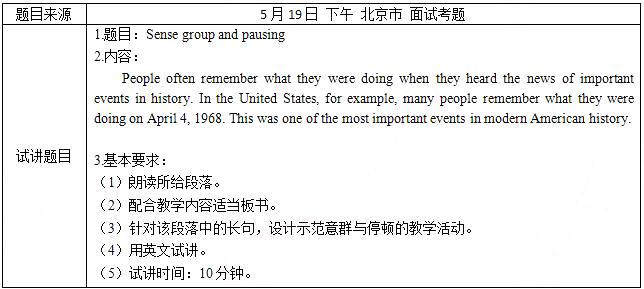
二、考题解析
【教案】
Teaching Aims:
Knowledge aim: Students will know what sense group is and master how to pause between sense groups.
Ability aim: Students can use the method to divide a long sentence into several parts and read the sentence more fluently.
Emotional aim: Students will improve their intonation and not be afraid of speaking English.
Teaching Key Points:
Students know the concept of sense group and pausing point of a long sentence.
Teaching Difficult Points:题目来源于考生回忆
Students can apply the pause between sense groups into daily reading to improve their pronunciation and intonation.
Teaching Methods:
Communicative teaching method, task-based teaching method, Audio-lingual teaching method.
Teaching Aids:
PPT, Blackboard and so on
Teaching Procedures:
Step 1: Warming up
1. Greetings
2.A tongue twister: I wish to wish the wish you wish to wish, but if you wish the wish the witch wishes, I won't wish the wish you wish to wish.
Step 2: Presentation题目来源于考生回忆
1.Ask students how to read a sentence quickly and in rhyme.
2.Read the first sentence twice. The first time without sense group pausing and the second time with it. Let students compare the two and find out the difference. Sense group is a meaning unit.
3.Explain the principle of sense group, which is according to
(1)grammar
(2)meaning
(3)punctuation
4. Divide the first sentence mainly according to grammar.
Step 3: Practice
1. Students read the first sentence, pausing according to sense group.
2. Students try to divide sense groups of the second sentence and read it.
Step 4: Production
Role-play: Students imagine a dialogue with a foreigner and apply sense group pausing in the dialogue. teacher will give them 10 minutes to prepare it and 10 minutes later, invite some students to role the conversation in the front.题目来源于考生回忆
Step 5: Summary & Homework
Summary : students look at the blackboard and summarize this class.
Homework: seek for a part of an English movie to make a dubbing.
Blackboard design:
 答案:解析:暂无解析
答案:解析:暂无解析 -
第20题:
单选题When teaching students how to give appropriate responses to a congratulation or an apology,the teacher is probably teaching at ______ .Alexical level
Bsentence level
Cgrammatical level
Ddiscourse level
正确答案: A解析: -
第21题:
单选题When students learn apple, orange, the teacher gives students another word fruit.Which principle does the teacher follow in his/her vocabulary teaching?AWord-choice principle.
BPresentation principle.
CCulture principle.
DSystematic principle.
正确答案: B解析: -
第22题:
单选题When the teacher gives feedback to students in teaching writing, he/she should NOT ______ .Amake positive comments on the good features of the writing
Bgive words simply like "good" or "very good" to the writing
Cpoint out areas for improvement
Dexpress his/her personal opinion on the issue the writer has discussed
正确答案: B解析: -
第23题:
单选题About principles of teaching reading, which description is wrong?AThe selected texts and attached tasks should be accessible to the students.
BTasks should be given after reading.
CTasks should help develop students' reading skills rather than test their reading comprehension.
DThe teacher should provide enough guidance and assistance at the beginning.
正确答案: A解析:
